Machine Learning Solutions for Offshore Wind Farms: A Review of Applications and Impacts
Abstract
:1. Introduction
2. Methods
3. Climatic Data Prediction and Environmental Effects
4. Performance Modeling and Optimization
5. Health Monitoring and Maintenance
6. Prospective
- Advanced Predictive Maintenance: Further advancements can be made in the realm of predictive maintenance by integrating real-time data from various sensors and sources. Research could focus on developing comprehensive models that not only predict failures but also recommend optimal maintenance schedules and strategies.
- Intelligent Control Systems: ML’s potential in control strategies is vast. Future research might delve into developing more intricate control algorithms that optimize the entire wind farm’s operation, considering multiple variables such as weather conditions, power demand, and energy storage.
- Multi-Physics and Hybrid ML Modeling: Integrating ML with multi-physics modeling could enhance the accuracy of predictions related to structural behavior, fatigue, and performance. Combining ML’s data-driven insights with physics-based models can provide a more holistic understanding of turbine dynamics. Further, combining the strengths of ML with physics-based models can lead to hybrid models that capture both empirical data and underlying physical principles. This can lead to more accurate and adaptable models that evolve with changing operational conditions.
- Enhanced Environmental Impact Assessment: ML can contribute significantly to environmental impact assessments, not just for marine ecosystems but also for interactions with other industries such as fishing. Future research might focus on developing more precise models that predict and mitigate the ecological consequences of offshore wind farms.
- Fusion of Data Types: The fusion of various data types, such as satellite imagery, weather forecasts, and oceanographic data, can lead to more accurate predictions. Future research could explore innovative techniques for combining these data sources effectively.
- Uncertainty Quantification: Addressing uncertainties in ML models, especially in power curve modeling and wake effects prediction, is crucial. Future studies could focus on developing methods to quantify and manage uncertainties, leading to more robust and reliable predictions.
- Explainability and Interpretability: As ML models become more complex, ensuring their interpretability and explainability becomes essential. Research could be directed towards developing techniques that provide insights into how these models arrive at their predictions, enhancing trust and adoption.
- Real-Time Decision Support: ML can play a pivotal role in providing real-time decision support for offshore operations. Future research might focus on developing systems that analyze vast amounts of data in real time and provide actionable insights for operators to optimize performance.
- Socio-Economic Impact Analysis: The expansion of offshore wind energy systems impacts not only the environment but also local economies and societies. Future research could delve into comprehensive socio-economic impact assessments, considering job creation, community development, and energy affordability. ML-based models can be implemented for the analysis and prediction of these potential impacts, especially resulting in the provision of insights for taking mitigating steps in the case of negative effects.
7. Conclusions
Funding
Data Availability Statement
Conflicts of Interest
References
- Kleist, N.; Enns, K. USGS BiblioSearch. 2022. Available online: https://code.usgs.gov/fort/bibliosearch/-/tree/v1.0.0 (accessed on 15 May 2023).
- Rose, M.E.; Kitchin, J.R. Pybliometrics: Scriptable bibliometrics using a Python interface to Scopus. SoftwareX 2019, 10, 100263. [Google Scholar] [CrossRef]
- Flores, P.; Tapia, A.; Tapia, G. Application of a control algorithm for wind speed prediction and active power generation. Renew. Energy 2005, 30, 523–536. [Google Scholar] [CrossRef]
- Dankert, H.; Horstmann, J. Wind measurements at FINO-I using marine radar-image sequences. In Proceedings of the International Geoscience and Remote Sensing Symposium, Seoul, Republic of Korea, 25–29 July 2005; Volume 7, p. 4777. [Google Scholar]
- Ma, Y.; Sclavounos, P.D.; Cross-Whiter, J.; Arora, D. Wave forecast and its application to the optimal control of offshore floating wind turbine for load mitigation. Renew. Energy 2018, 128, 163–176. [Google Scholar] [CrossRef]
- Kulkarni, S.; Deo, M.; Ghosh, S. Framework for assessment of climate change impact on offshore wind energy. Meteorol. Appl. 2018, 25, 94–104. [Google Scholar] [CrossRef]
- Niemi, J.; Tanttu, J.T. Deep learning case study for automatic bird identification. Appl. Sci. 2018, 8, 2089. [Google Scholar] [CrossRef]
- Niemi, J.; Tanttu, J.T. Automatic bird identification for offshore wind farms. In Wind Energy and Wildlife Impacts: Balancing Energy Sustainability with Wildlife Conservation; Springer: Berlin/Heidelberg, Germany, 2019; pp. 135–151. [Google Scholar]
- Yan, C.; Pan, Y.; Archer, C.L. A general method to estimate wind farm power using artificial neural networks. Wind Energy 2019, 22, 1421–1432. [Google Scholar] [CrossRef]
- Keivanpour, S.; Ramudhin, A.; Ait Kadi, D.; Kimiagari, S. Global offshore wind energy deployment: A geo-clustering approach. Int. J. Green Energy 2019, 16, 1054–1060. [Google Scholar] [CrossRef]
- Zha, T.; Xie, L.; Chang, J. Wind farm water area path planning algorithm based on A and reinforcement learning. In Proceedings of the 2019 5th International Conference on Transportation Information and Safety (ICTIS), Liverpool, UK, 14–17 July 2019; pp. 1314–1318. [Google Scholar]
- Lin, T.H.; Yang, H.T.; Huang, J.M.; Yao, C.J.; Lien, Y.S.; Wang, P.J.; Hu, F.Y. Evaluating changes in the marine soundscape of an offshore wind farm via the machine learning-based source separation. In Proceedings of the 2019 IEEE Underwater Technology (UT), Kaohsiung, Taiwan, 16–19 April 2019; pp. 1–6. [Google Scholar]
- Friedland, K.D.; Methratta, E.T.; Gill, A.B.; Gaichas, S.K.; Curtis, T.H.; Adams, E.M.; Morano, J.L.; Crear, D.P.; McManus, M.C.; Brady, D.C. Resource occurrence and productivity in existing and proposed wind energy lease areas on the Northeast US Shelf. Front. Mar. Sci. 2021, 8, 629230. [Google Scholar] [CrossRef]
- Stelzenmüller, V.; Gimpel, A.; Haslob, H.; Letschert, J.; Berkenhagen, J.; Brüning, S. Sustainable co-location solutions for offshore wind farms and fisheries need to account for socio-ecological trade-offs. Sci. Total Environ. 2021, 776, 145918. [Google Scholar] [CrossRef]
- Van Der Reijden, K.J.; Govers, L.L.; Koop, L.; Damveld, J.H.; Herman, P.M.; Mestdagh, S.; Piet, G.; Rijnsdorp, A.D.; Dinesen, G.E.; Snellen, M.; et al. Beyond connecting the dots: A multi-scale, multi-resolution approach to marine habitat mapping. Ecol. Indic. 2021, 128, 107849. [Google Scholar] [CrossRef]
- Tapoglou, E.; Forster, R.M.; Dorrell, R.M.; Parsons, D. Machine learning for satellite-based sea-state prediction in an offshore windfarm. Ocean Eng. 2021, 235, 109280. [Google Scholar] [CrossRef]
- Masoumi, M. Ocean data classification using unsupervised machine learning: Planning for hybrid wave-wind offshore energy devices. Ocean Eng. 2021, 219, 108387. [Google Scholar] [CrossRef]
- Hoeser, T.; Feuerstein, S.; Kuenzer, C. DeepOWT: A global offshore wind turbine data set derived with deep learning from Sentinel-1 data. Earth Syst. Sci. Data 2022, 14, 4251–4270. [Google Scholar] [CrossRef]
- Hoeser, T.; Kuenzer, C. SyntEO: Synthetic dataset generation for earth observation and deep learning–Demonstrated for offshore wind farm detection. ISPRS J. Photogramm. Remote Sens. 2022, 189, 163–184. [Google Scholar] [CrossRef]
- Nguyen, T.h.; Toubeau, J.F.; De Jaeger, E.; Vallée, F. Adequacy assessment using data-driven models to account for aerodynamic losses in offshore wind generation. Electr. Power Syst. Res. 2022, 211, 108599. [Google Scholar] [CrossRef]
- Mikami, K.; Kazama, K.; Kazama, M.T.; Watanuki, Y. Mapping the collision risk between two gull species and offshore wind turbines: Modelling and validation. J. Environ. Manag. 2022, 316, 115220. [Google Scholar] [CrossRef]
- Xu, Z.; Zhang, H.; Wang, Y.; Wang, X.; Xue, S.; Liu, W. Dynamic detection of offshore wind turbines by spatial machine learning from spaceborne synthetic aperture radar imagery. J. King Saud Univ.-Comput. Inf. Sci. 2022, 34, 1674–1686. [Google Scholar] [CrossRef]
- Roy, S.; Sentchev, A.; Fourmentin, M.; Augustin, P. Machine Learning and Deterministic Methods for Detection Meteorological Phenomena from Ground Measurements: Application for Low-Level Jet and Sea-Breeze Identification in Northern France. Atmosphere 2022, 13, 1873. [Google Scholar] [CrossRef]
- Marin, R.; Ciortan, S.; Rusu, E. A novel method based on artificial neural networks for selecting the most appropriate locations of the offshore wind farms. Energy Rep. 2022, 8, 408–413. [Google Scholar] [CrossRef]
- Clare, M.C.; Piggott, M.D. Bayesian neural networks for the probabilistic forecasting of wind direction and speed using ocean data. In Trends in Renewable Energies Offshore; CRC Press: Boca Raton, FL, USA, 2022; pp. 533–540. [Google Scholar]
- Yu, Y.; Wu, Y.; Zhao, L.; Li, X.; Li, Y. Ultra Short Term Power Prediction of Offshore Wind Power Based on Support Vector Machine Optimized by Improved Dragonfly Algorithm. Distrib. Gener. Altern. Energy J. 2022, 37, 465–484. [Google Scholar] [CrossRef]
- Dong, H.; Xie, J.; Zhao, X. Wind farm control technologies: From classical control to reinforcement learning. Prog. Energy 2022, 4, 032006. [Google Scholar] [CrossRef]
- Lee, K.H.; Jun, S.O.; Pak, K.H.; Lee, D.H.; Lee, K.W.; Park, J.P. Numerical optimization of site selection for offshore wind turbine installation using genetic algorithm. Curr. Appl. Phys. 2010, 10, S302–S306. [Google Scholar] [CrossRef]
- Pappala, V.S.; Nakawiro, W.; Erlich, I. Predictive optimal control of wind farm reactive sources. In Proceedings of the IEEE PES T&D 2010, New Orleans, LA, USA, 19–22 April 2010; pp. 1–7. [Google Scholar]
- Japar, F.; Mathew, S.; Narayanaswamy, B.; Lim, C.M.; Hazra, J. Estimating the wake losses in large wind farms: A machine learning approach. In Proceedings of the ISGT 2014, Washington, DC, USA, 19–22 February 2014; pp. 1–5. [Google Scholar]
- Barthelmie, R.J.; Frandsen, S.T.; Rathmann, O.; Hansen, K.S.; Politis, E.S.; Prospathopoulos, J.; Cabezón Martínez, D.; Rados, K.; Van Der Pijl, S.; Schepers, J.; et al. Flow and wakes in large wind farms in complex terrain and offshore. In Proceedings of the European Wind Energy Conference & Exhibition (EWEC 2008), Brussels, Belgium, 31 March–3 April 2008. [Google Scholar]
- Antoniadou, I.; Dervilis, N.; Papatheou, E.; Maguire, A.; Worden, K. Aspects of structural health and condition monitoring of offshore wind turbines. Philos. Trans. R. Soc. A Math. Phys. Eng. Sci. 2015, 373, 20140075. [Google Scholar] [CrossRef] [PubMed]
- Rodrigues, S.; Pinto, R.T.; Bauer, P.; Brys, T.; Nowé, A. Online distributed voltage control of an offshore MTDC network using reinforcement learning. In Proceedings of the 2015 IEEE Congress on Evolutionary Computation (CEC), Sendai, Japan, 25–28 May 2015; pp. 1769–1775. [Google Scholar]
- Ou, T.C.; Lu, K.H.; Huang, C.J. Improvement of transient stability in a hybrid power multi-system using a designed NIDC (Novel Intelligent Damping Controller). Energies 2017, 10, 488. [Google Scholar] [CrossRef]
- Fischetti, M.; Fraccaro, M. Using OR+ AI to predict the optimal production of offshore wind parks: A preliminary study. In Proceedings of the Optimization and Decision Science: Methodologies and Applications: ODS, Sorrento, Italy, 4–7 September 2017; Springer: Berlin/Heidelberg, Germany, 2017; pp. 203–211. [Google Scholar]
- Fischetti, M.; Fraccaro, M. Machine learning meets mathematical optimization to predict the optimal production of offshore wind parks. Comput. Oper. Res. 2019, 106, 289–297. [Google Scholar] [CrossRef]
- Lu, K.H.; Chen, H.C.; Su, Y.; Xu, Q. Design of an Intelligent Damping Controller of STATCOM with HVDC for Large Offshore Wind Farm. J. Mar. Sci. Technol. 2018, 26, 10. [Google Scholar]
- Noppe, N.; Weijtjens, W.; Devriendt, C. Modeling of quasi-static thrust load of wind turbines based on 1 s SCADA data. Wind Energy Sci. 2018, 3, 139–147. [Google Scholar] [CrossRef]
- Lu, K.H.; Hong, C.M.; Xu, Q. Recurrent wavelet-based Elman neural network with modified gravitational search algorithm control for integrated offshore wind and wave power generation systems. Energy 2019, 170, 40–52. [Google Scholar] [CrossRef]
- Häfele, J.; Gebhardt, C.G.; Rolfes, R. A comparison study on jacket substructures for offshore wind turbines based on optimization. Wind Energy Sci. 2019, 4, 23–40. [Google Scholar] [CrossRef]
- Yin, X.; Zhao, X. Big data driven multi-objective predictions for offshore wind farm based on machine learning algorithms. Energy 2019, 186, 115704. [Google Scholar] [CrossRef]
- Niayifar, A.; Porté-Agel, F. A new analytical model for wind farm power prediction. J. Phys. Conf. Ser. 2015, 625, 012039. [Google Scholar] [CrossRef]
- Pillai, A.C.; Thies, P.R.; Johanning, L. Mooring system design optimization using a surrogate assisted multi-objective genetic algorithm. Eng. Optim. 2018, 51, 1370–1392. [Google Scholar] [CrossRef]
- Li, F.; Zhou, L.; Li, L.; Wang, H.; Guo, H.; Liang, Y. Individual blade pitch control for floating wind turbine based on rbf-smc. In Proceedings of the 2019 IEEE 3rd Conference on Energy Internet and Energy System Integration (EI2), Changsha, China, 8–10 November 2019; pp. 949–953. [Google Scholar]
- Shin, H. Model test of the OC3-Hywind floating offshore wind turbine. In Proceedings of the ISOPE International Ocean and Polar Engineering Conference, Maui, HI, USA, 19–24 June 2011; ISOPE: Mountain View, CA, USA, 2011; p. ISOPE–I. [Google Scholar]
- Penner, N.; Grießmann, T.; Rolfes, R. Monitoring of suction bucket jackets for offshore wind turbines: Dynamic load bearing behaviour and modelling. Mar. Struct. 2020, 72, 102745. [Google Scholar] [CrossRef]
- Jonkman, J. OpenFAST: An Open Source Wind Turbine Simulation Tool. Available online: https://www.nrel.gov/wind/nwtc/openfast.html (accessed on 2 May 2023).
- Vijayakumar, G.; Yellapantula, S.; Branlard, E.; Ananthan, S. Enhancement of unsteady and 3D aerodynamics models using machine learning. J. Phys. Conf. Ser. 2020, 1452, 012065. [Google Scholar] [CrossRef]
- De Brabanter, K.; De Brabanter, J.; Suykens, J.A.; De Moor, B. Approximate confidence and prediction intervals for least squares support vector regression. IEEE Trans. Neural Netw. 2010, 22, 110–120. [Google Scholar] [CrossRef]
- Pandit, R.; Kolios, A. SCADA data-based support vector machine wind turbine power curve uncertainty estimation and its comparative studies. Appl. Sci. 2020, 10, 8685. [Google Scholar] [CrossRef]
- Zhou, J.; Cui, G.; Hu, S.; Zhang, Z.; Yang, C.; Liu, Z.; Wang, L.; Li, C.; Sun, M. Graph neural networks: A review of methods and applications. AI Open 2020, 1, 57–81. [Google Scholar] [CrossRef]
- Yu, M.; Zhang, Z.; Li, X.; Yu, J.; Gao, J.; Liu, Z.; You, B.; Zheng, X.; Yu, R. Superposition graph neural network for offshore wind power prediction. Future Gener. Comput. Syst. 2020, 113, 145–157. [Google Scholar] [CrossRef]
- Dong, H.; Zhang, J.; Zhao, X. Intelligent wind farm control via deep reinforcement learning and high-fidelity simulations. Appl. Energy 2021, 292, 116928. [Google Scholar] [CrossRef]
- Fleming, P.; Gebraad, P.; Churchfield, M.; Lee, S.; Johnson, K.; Michalakes, J.; van Wingerden, J.W.; Moriarty, P. SOWFA+ Super Controller User’s Manual; Technical Report; National Renewable Energy Lab. (NREL): Golden, CO, USA, 2013. [Google Scholar]
- Developers, T. TensorFlow; Zenodo: Honolulu, HI, USA, 2022. [Google Scholar]
- Lian, J.; Zhao, Y.; Dong, X.; Lian, C.; Wang, H. An experimental investigation on long-term performance of the wide-shallow bucket foundation model for offshore wind turbine in saturated sand. Ocean Eng. 2021, 228, 108921. [Google Scholar] [CrossRef]
- Chen, P.; Song, L.; Chen, J.h.; Hu, Z. Simulation-annealing diagnosis algorithm method for optimized forecast of the dynamic response of floating offshore wind turbines. J. Hydrodyn. 2021, 33, 216–225. [Google Scholar] [CrossRef]
- Miao, Y.; Huang, L.l.; Liu, Y.; Ying, F.; Song, M. Energy Availability Analysis of Offshore Wind Farms Considering the Correlation between Wind Speed Cloud Model and Parameters. In Proceedings of the 2021 11th International Conference on Power and Energy Systems (ICPES), Virtual, 18–20 December 2021; pp. 707–712. [Google Scholar]
- Mattsson, N.; Verendel, V.; Hedenus, F.; Reichenberg, L. An autopilot for energy models–Automatic generation of renewable supply curves, hourly capacity factors and hourly synthetic electricity demand for arbitrary world regions. Energy Strategy Rev. 2021, 33, 100606. [Google Scholar] [CrossRef]
- ERA, C. Fifth Generation of ECMWF Atmospheric Reanalyses of the Global Climate. Copernicus Climate Change Service Climate Data Store (CDS); ECMWF: Reading, UK, 2017. [Google Scholar]
- Kheirabadi, A.C.; Nagamune, R. A Dynamic Parametric Wind Farm Model for Simulating Time-varying Wind Conditions and Floating Platform Motion. arXiv 2020, arXiv:2009.02585. [Google Scholar]
- Kheirabadi, A.C.; Nagamune, R. Real-time relocation of floating offshore wind turbines for power maximization using distributed economic model predictive control. In Proceedings of the 2021 American Control Conference (ACC), New Orleans, LA, USA, 25–28 May 2021; pp. 3077–3081. [Google Scholar]
- Yin, X.; Zhao, X. Deep neural learning based distributed predictive control for offshore wind farm using high-fidelity LES data. IEEE Trans. Ind. Electron. 2020, 68, 3251–3261. [Google Scholar] [CrossRef]
- Anagnostopoulos, S.; Piggott, M. Offshore wind farm wake modelling using deep feed forward neural networks for active yaw control and layout optimisation. J. Phys. Conf. Ser. 2022, 2151, 012011. [Google Scholar] [CrossRef]
- Bay, C.; King, J.R.; Fleming, P.A.; Martinez, L.; Mudafort, R.M.; Simley, E.J.; Lawson, M.J. Floris: A Brief Tutorial; Technical Report; National Renewable Energy Lab. (NREL): Golden, CO, USA, 2020. [Google Scholar]
- Jothinathan, S.; Kashyap, S.; Kumar, D.; Saha, N. Response control of fixed offshore structure with wind turbine using MR damper. In Proceedings of the OCEANS 2022, Chennai, India, 21–24 February 2022; pp. 1–8. [Google Scholar]
- Keighobadi, J.; KhalafAnsar, H.M.; Naseradinmousavi, P. Adaptive neural dynamic surface control for uniform energy exploitation of floating wind turbine. Appl. Energy 2022, 316, 119132. [Google Scholar] [CrossRef]
- Kayedpour, N.; Samani, A.E.; De Kooning, J.D.; Vandevelde, L.; Crevecoeur, G. Model predictive control with a cascaded hammerstein neural network of a wind turbine providing frequency containment reserve. IEEE Trans. Energy Convers. 2021, 37, 198–209. [Google Scholar] [CrossRef]
- Zhang, J.; Zhao, X.; Wei, X. Reinforcement learning-based structural control of floating wind turbines. IEEE Trans. Syst. Man Cybern. Syst. 2020, 52, 1603–1613. [Google Scholar] [CrossRef]
- Dehghan Manshadi, M.; Mousavi, M.; Soltani, M.; Mosavi, A.; Kovacs, L. Deep learning for modeling an offshore hybrid wind–wave energy system. Energies 2022, 15, 9484. [Google Scholar] [CrossRef]
- He, J. Coherence and cross-spectral density matrix analysis of random wind and wave in deep water. Ocean Eng. 2020, 197, 106930. [Google Scholar] [CrossRef]
- Velino, J.; Kang, S.; Kane, M.B. Machine Learning Control for Floating Offshore Wind Turbine Individual Blade Pitch Control. J. Comput. Civ. Eng. 2022, 36, 04022034. [Google Scholar] [CrossRef]
- Yonggao, G.; Yi, T. Auxiliary Decision-making Method for Reactive Power Compensation Configuration of AC Grid-connected Offshore Wind Farm. In Proceedings of the 2022 IEEE 5th International Electrical and Energy Conference (CIEEC), Nanjing, China, 27–29 May 2022; pp. 2887–2892. [Google Scholar]
- Meng, Y.; Chang, C.; Huo, J.; Zhang, Y.; Mohammed Al-Neshmi, H.M.; Xu, J.; Xie, T. Research on ultra-short-term prediction model of wind power based on attention mechanism and CNN-BiGRU combined. Front. Energy Res. 2022, 10, 920835. [Google Scholar] [CrossRef]
- Zhang, Y.; Yang, X.; Liu, S. Data-driven predictive control for floating offshore wind turbines based on deep learning and multi-objective optimization. Ocean Eng. 2022, 266, 112820. [Google Scholar] [CrossRef]
- Hall, M. MoorDyn User’s Guide; Department of Mechanical Engineering, University of Maine: Orono, ME, USA, 2015; Volume 15. [Google Scholar]
- Pham, T.; Li, X. Neural Network-based Power Flow Model. In Proceedings of the 2022 IEEE Green Technologies Conference (GreenTech), Houston, TX, USA, 30 March–1 April 2022; pp. 105–109. [Google Scholar]
- Chen, P.; Hu, Z.Q. A Study on Key Disciplinary Parameters of Artificial Intelligent-Based Analysis Method for Dynamic Response Prediction of Floating Offshore Wind Turbines. J. Offshore Mech. Arct. Eng. 2023, 145, 010906. [Google Scholar] [CrossRef]
- Yang, K.; Deng, X. Layout optimization for renovation of operational offshore wind farm based on machine learning wake model. J. Wind. Eng. Ind. Aerodyn. 2023, 232, 105280. [Google Scholar] [CrossRef]
- Ahmad, I.; M’zoughi, F.; Aboutalebi, P.; Garrido, I.; Garrido, A.J. Fuzzy logic control of an artificial neural network-based floating offshore wind turbine model integrated with four oscillating water columns. Ocean Eng. 2023, 269, 113578. [Google Scholar] [CrossRef]
- Ahmad, I.; M’zoughi, F.; Aboutalebi, P.; Garrido, I.; Garrido, A.J. A regressive machine-learning approach to the non-linear complex FAST model for hybrid floating offshore wind turbines with integrated oscillating water columns. Sci. Rep. 2023, 13, 1499. [Google Scholar] [CrossRef]
- Hui, H.; Xiu-wen, L.; Jing-yu, B. The application of artificial intelligence technology in the fault diagnosis of floating wind turbine generator. In Proceedings of the 2020 5th International Conference on Electromechanical Control Technology and Transportation (ICECTT), Nanchang, China, 15–17 May 2020; pp. 305–307. [Google Scholar]
- Black, I.M.; Richmond, M.; Kolios, A. Condition monitoring systems: A systematic literature review on machine-learning methods improving offshore-wind turbine operational management. Int. J. Sustain. Energy 2021, 40, 923–946. [Google Scholar] [CrossRef]
- Okenyi, V.; Bodaghi, M.; Mansfield, N.; Afazov, S.; Siegkas, P. A review of challenges and framework development for corrosion fatigue life assessment of monopile-supported horizontal-axis offshore wind turbines. Ships Offshore Struct. 2022, 1–15. [Google Scholar] [CrossRef]
- Pezeshki, H.; Adeli, H.; Pavlou, D.; Siriwardane, S.C. State of the art in structural health monitoring of offshore and marine structures. In Institution of Civil Engineers-Maritime Engineering; Thomas Telford Ltd.: London, UK, 2023; Volume 176, pp. 89–108. [Google Scholar]
- Hameed, Z.; Wang, K. Development of optimal maintenance strategies for offshore wind turbine by using artificial neural network. Wind. Eng. 2012, 36, 353–364. [Google Scholar] [CrossRef]
- Wang, Y.; Infield, D. Supervisory control and data acquisition data-based non-linear state estimation technique for wind turbine gearbox condition monitoring. IET Renew. Power Gener. 2013, 7, 350–358. [Google Scholar] [CrossRef]
- Dervilis, N.; Creech, A.; Maguire, A.E.; Antoniadou, I.; Barthorpe, R.; Worden, K. An SHM view of a CFD model of Lillgrund wind farm. Appl. Mech. Mater. 2014, 564, 164–169. [Google Scholar] [CrossRef]
- Creech, A.C.; Fruh, W.G.; Maguire, A.E. High-resolution CFD modelling of Lillgrund Wind farm. In Proceedings of the International Conference on Renewable Energies and Power Quality, Bilbao, Spain, 20–22 March 2013. [Google Scholar]
- Dahlberg, J.A. Assessment of the Lillgrund Windfarm, Power Performance and Wake Effects; Lillgrund Pilot Project; Vattenfall Vindkraft AB: Solna, Sweden, 2009. [Google Scholar]
- Pattison, D.; Segovia Garcia, M.; Xie, W.; Quail, F.; Revie, M.; Whitfield, R.; Irvine, I. Intelligent integrated maintenance for wind power generation. Wind Energy 2016, 19, 547–562. [Google Scholar] [CrossRef]
- Helsen, J.; Gioia, N.; Peeters, C.; Jordaens, P.J. Integrated condition monitoring of a fleet of offshore wind turbines with focus on acceleration streaming processing. J. Phys. Conf. Ser. 2017, 842, 012052. [Google Scholar] [CrossRef]
- Li, C.B.; Choung, J. Fatigue damage analysis for a floating offshore wind turbine mooring line using the artificial neural network approach. Ships Offshore Struct. 2017, 12, S288–S295. [Google Scholar] [CrossRef]
- Jonkman, J.; Butterfield, S.; Musial, W.; Scott, G. Definition of a 5-MW Reference wind Turbine for Offshore System Development; Technical Report; National Renewable Energy Lab. (NREL): Golden, CO, USA, 2009. [Google Scholar]
- Robertson, A.; Jonkman, J.; Masciola, M.; Song, H.; Goupee, A.; Coulling, A.; Luan, C. Definition of the Semisubmersible Floating System for Phase II of OC4; Technical Report; National Renewable Energy Lab. (NREL): Golden, CO, USA, 2014. [Google Scholar]
- Kandukuri, S.T.; Senanayaka, J.S.L.; Huynh, V.K.; Robbersmyr, K.G. A two-stage fault detection and classification for electric pitch drives in offshore wind farms using support vector machine. In Proceedings of the 2017 20th International Conference on Electrical Machines and Systems (ICEMS), Sydney, Australia, 11–14 August 2017; pp. 1–6. [Google Scholar]
- Bak, C.; Zahle, F.; Bitsche, R.; Kim, T.; Yde, A.; Henriksen, L.C.; Hansen, M.H.; Blasques, J.P.A.A.; Gaunaa, M.; Natarajan, A. The DTU 10-MW reference wind turbine. In Danish Wind Power Research 2013; DTU: Lyngby, Denmark, 2013. [Google Scholar]
- Sandner, F.; Yu, W.; Matha, D.; Azcona, J.; Munduate, X.; Grela, E.; Voutsinas, S.; Natarajan, A. INNWIND. EU D4. 33: Innovative Concepts for Floating Structures; Technical Report; DTU: Lyngby, Denmark, 2014. [Google Scholar]
- Müller, K.; Dazer, M.; Cheng, P.W. Damage assessment of floating offshore wind turbines using response surface modeling. Energy Procedia 2017, 137, 119–133. [Google Scholar] [CrossRef]
- Li, C.B.; Choung, J.; Noh, M.H. Wide-banded fatigue damage evaluation of Catenary mooring lines using various Artificial Neural Networks models. Mar. Struct. 2018, 60, 186–200. [Google Scholar] [CrossRef]
- Lu, Y.; Sun, L.; Zhang, X.; Feng, F.; Kang, J.; Fu, G. Condition based maintenance optimization for offshore wind turbine considering opportunities based on neural network approach. Appl. Ocean. Res. 2018, 74, 69–79. [Google Scholar] [CrossRef]
- Papatzimos, A.K.; Dawood, T.; Thies, P.R. Data insights from an offshore wind turbine gearbox replacement. J. Phys. Conf. Ser. 2018, 1104, 012003. [Google Scholar] [CrossRef]
- Papatzimos, A.K.; Dawood, T.; Thies, P.R. Operational data to maintenance optimization: Closing the loop in offshore wind O&M. In Proceedings of the International Conference on Offshore Mechanics and Arctic Engineering, Madrid, Spain, 17–22 June 2018; American Society of Mechanical Engineers. New York, NY, USA, 2018; Volume 51975, p. V001T01A038. [Google Scholar]
- Ziegler, L.; Cosack, N.; Kolios, A.; Muskulus, M. Structural monitoring for lifetime extension of offshore wind monopiles: Verification of strain-based load extrapolation algorithm. Mar. Struct. 2019, 66, 154–163. [Google Scholar] [CrossRef]
- Cavazzini, A.; Minisci, E.; Campobasso, M.S. Machine learning-aided assessment of wind turbine energy losses due to blade leading edge damage. In Proceedings of the International Conference on Offshore Mechanics and Arctic Engineering, St. Julian’s, Malta, 3–6 November 2019; American Society of Mechanical Engineers: New York, NY, USA, 2019; Volume 59353, p. V001T01A005. [Google Scholar]
- Qiu, B.; Lu, Y.; Sun, L.; Qu, X.; Xue, Y.; Tong, F. Research on the damage prediction method of offshore wind turbine tower structure based on improved neural network. Measurement 2020, 151, 107141. [Google Scholar] [CrossRef]
- Langenkämper, D.; Möller, T.; Brün, D.; Nattkemper, T.W. Efficient visual monitoring of offshore windmill installations with online image annotation and deep learning computer vision. In Proceedings of the Global Oceans 2020: Singapore–US Gulf Coast, Virtual, 5–14 October 2020; pp. 1–6. [Google Scholar]
- Girshick, R. Fast R-CNN. In Proceedings of the IEEE International Conference on Computer Vision, Santiago, Chile, 7–13 December 2015; IEEE: Piscataway, NJ, USA, 2015; Volume 2, pp. 1440–1448. [Google Scholar]
- Wang, X.; Gao, X.; Liu, Y.; Wang, Y. WRC-SDT based on-line detection method for offshore wind farm transmission line. IEEE Access 2020, 8, 53547–53560. [Google Scholar] [CrossRef]
- Hoxha, E.; Vidal, Y.; Pozo, F. Damage diagnosis for offshore wind turbine foundations based on the fractal dimension. Appl. Sci. 2020, 10, 6972. [Google Scholar] [CrossRef]
- Li, X.; Zhang, W. Long-term fatigue damage assessment for a floating offshore wind turbine under realistic environmental conditions. Renew. Energy 2020, 159, 570–584. [Google Scholar] [CrossRef]
- Schröder, L.; Dimitrov, N.K.; Verelst, D.R. A surrogate model approach for associating wind farm load variations with turbine failures. Wind Energy Sci. 2020, 5, 1007–1022. [Google Scholar] [CrossRef]
- Teimourzadeh Baboli, P.; Babazadeh, D.; Raeiszadeh, A.; Horodyvskyy, S.; Koprek, I. Optimal temperature-based condition monitoring system for wind turbines. Infrastructures 2021, 6, 50. [Google Scholar] [CrossRef]
- Cho, S.; Choi, M.; Gao, Z.; Moan, T. Fault detection and diagnosis of a blade pitch system in a floating wind turbine based on Kalman filters and artificial neural networks. Renew. Energy 2021, 169, 1–13. [Google Scholar] [CrossRef]
- Pandit, R.; Infield, D.; Dodwell, T. Operational variables for improving industrial wind turbine yaw misalignment early fault detection capabilities using data-driven techniques. IEEE Trans. Instrum. Meas. 2021, 70, 1–8. [Google Scholar] [CrossRef]
- Trizoglou, P.; Liu, X.; Lin, Z. Fault detection by an ensemble framework of Extreme Gradient Boosting (XGBoost) in the operation of offshore wind turbines. Renew. Energy 2021, 179, 945–962. [Google Scholar] [CrossRef]
- Feijóo, M.d.C.; Zambrano, Y.; Vidal, Y.; Tutivén, C. Unsupervised damage detection for offshore jacket wind turbine foundations based on an autoencoder neural network. Sensors 2021, 21, 3333. [Google Scholar] [CrossRef]
- Roelofs, C.M.; Lutz, M.A.; Faulstich, S.; Vogt, S. Autoencoder-based anomaly root cause analysis for wind turbines. Energy AI 2021, 4, 100065. [Google Scholar] [CrossRef]
- EDP Inovação. EDPR Wind Farm Open Data: Wind Turbine SCADA Signals and Historical Failure Logbook from 2016 and 2017; EDP Inovação: Lisbon, Portugal, 2018. [Google Scholar]
- Tang, W.; Gu, Y.; Xin, Y.; Liang, Q.; Qian, T. Classification for transient overvoltages in offshore wind farms based on sparse decomposition. IEEE Trans. Power Deliv. 2021, 37, 1974–1985. [Google Scholar] [CrossRef]
- Tang, W.; Gu, Y.; Xin, Y.; Liang, Q.; Qian, T. Classification for transient overvoltages in offshore wind farms based on multi-scale mathematical morphology. Int. J. Electr. Power Energy Syst. 2022, 136, 107157. [Google Scholar] [CrossRef]
- Yeter, B.; Garbatov, Y.; Soares, C.G. Life-extension classification of offshore wind assets using unsupervised machine learning. Reliab. Eng. Syst. Saf. 2022, 219, 108229. [Google Scholar] [CrossRef]
- Santos, F.d.N.; Noppe, N.; Weijtjens, W.; Devriendt, C. Data-driven farm-wide fatigue estimation on jacket-foundation OWTs for multiple SHM setups. Wind Energy Sci. 2022, 7, 299–321. [Google Scholar] [CrossRef]
- Xu, Z.; Bashir, M.; Yang, Y.; Wang, X.; Wang, J.; Ekere, N.; Li, C. Multisensory collaborative damage diagnosis of a 10 MW floating offshore wind turbine tendons using multi-scale convolutional neural network with attention mechanism. Renew. Energy 2022, 199, 21–34. [Google Scholar] [CrossRef]
- Eze, O.; Guile, G.R.; Wang, W. Detecting the Faults of Subsea Power Cables of Wind Farms with Boosting Ensemble Methods. In Proceedings of the 2022 International Conference on Electrical, Computer, Communications and Mechatronics Engineering (ICECCME), Maldives, Maldives, 16–18 November 2022; pp. 1–6. [Google Scholar]
- Narkhede, S. Understanding auc-roc curve. Towards Data Sci. 2018, 26, 220–227. [Google Scholar]
- Chicco, D.; Jurman, G. The advantages of the Matthews correlation coefficient (MCC) over F1 score and accuracy in binary classification evaluation. BMC Genom. 2020, 21, 6. [Google Scholar] [CrossRef]
- Encalada-Dávila, Á.; Tutivén Gálvez, C.; Moyón, L.; Puruncajas Maza, B.; Vidal Seguí, Y. Main bearing fault prognosis in wind turbines based on gated recurrent unit neural networks. Renew. Energy Power Qual. J. 2022, 20, 419–424. [Google Scholar] [CrossRef]
- Attallah, O.; Ibrahim, R.A.; Zakzouk, N.E. CAD system for inter-turn fault diagnosis of offshore wind turbines via multi-CNNs & feature selection. Renew. Energy 2023, 203, 870–880. [Google Scholar]
- Khanjani, M.; Ezoji, M. Electrical fault detection in three-phase induction motor using deep network-based features of thermograms. Measurement 2021, 173, 108622. [Google Scholar] [CrossRef]
- Mahami, A.; Rahmoune, C.; Bettahar, T.; Benazzouz, D. Induction motor condition monitoring using infrared thermography imaging and ensemble learning techniques. Adv. Mech. Eng. 2021, 13, 16878140211060956. [Google Scholar] [CrossRef]
- Saleh, A.; Chiachío, M.; Salas, J.F.; Kolios, A. Self-adaptive optimized maintenance of offshore wind turbines by intelligent Petri nets. Reliab. Eng. Syst. Saf. 2023, 231, 109013. [Google Scholar] [CrossRef]
- Sun, K.; Xu, Z.; Li, S.; Jin, J.; Wang, P.; Yue, M.; Li, C. Dynamic response analysis of floating wind turbine platform in local fatigue of mooring. Renew. Energy 2023, 204, 733–749. [Google Scholar] [CrossRef]
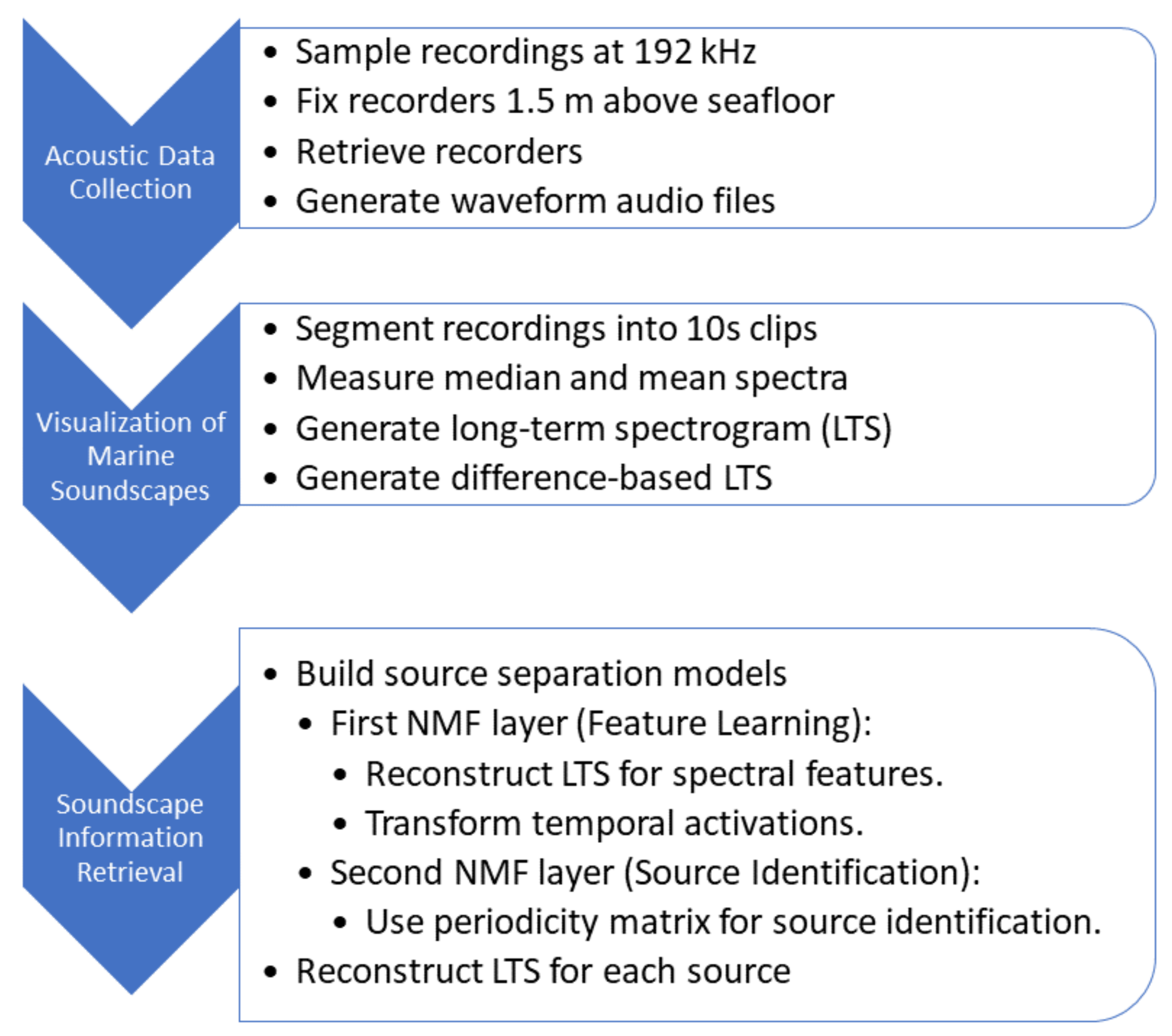
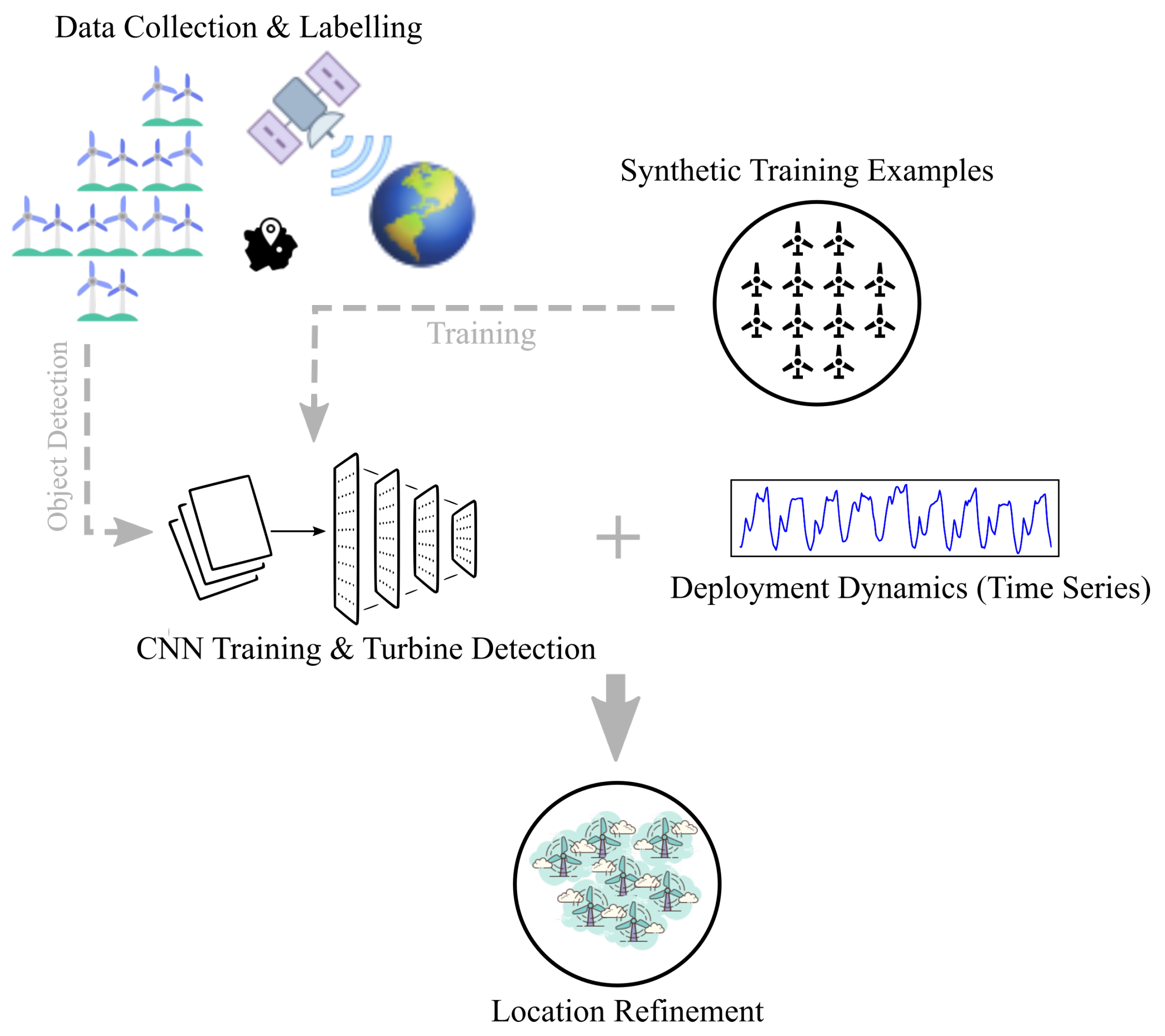
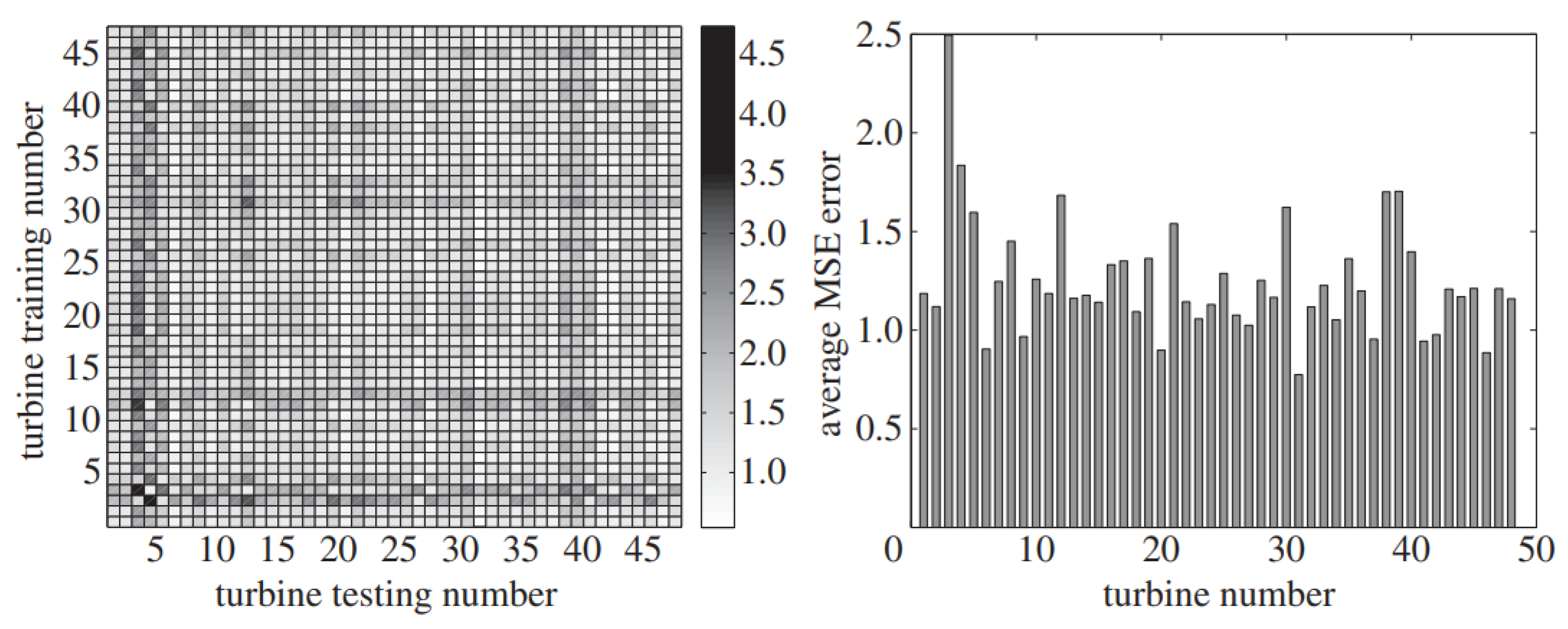
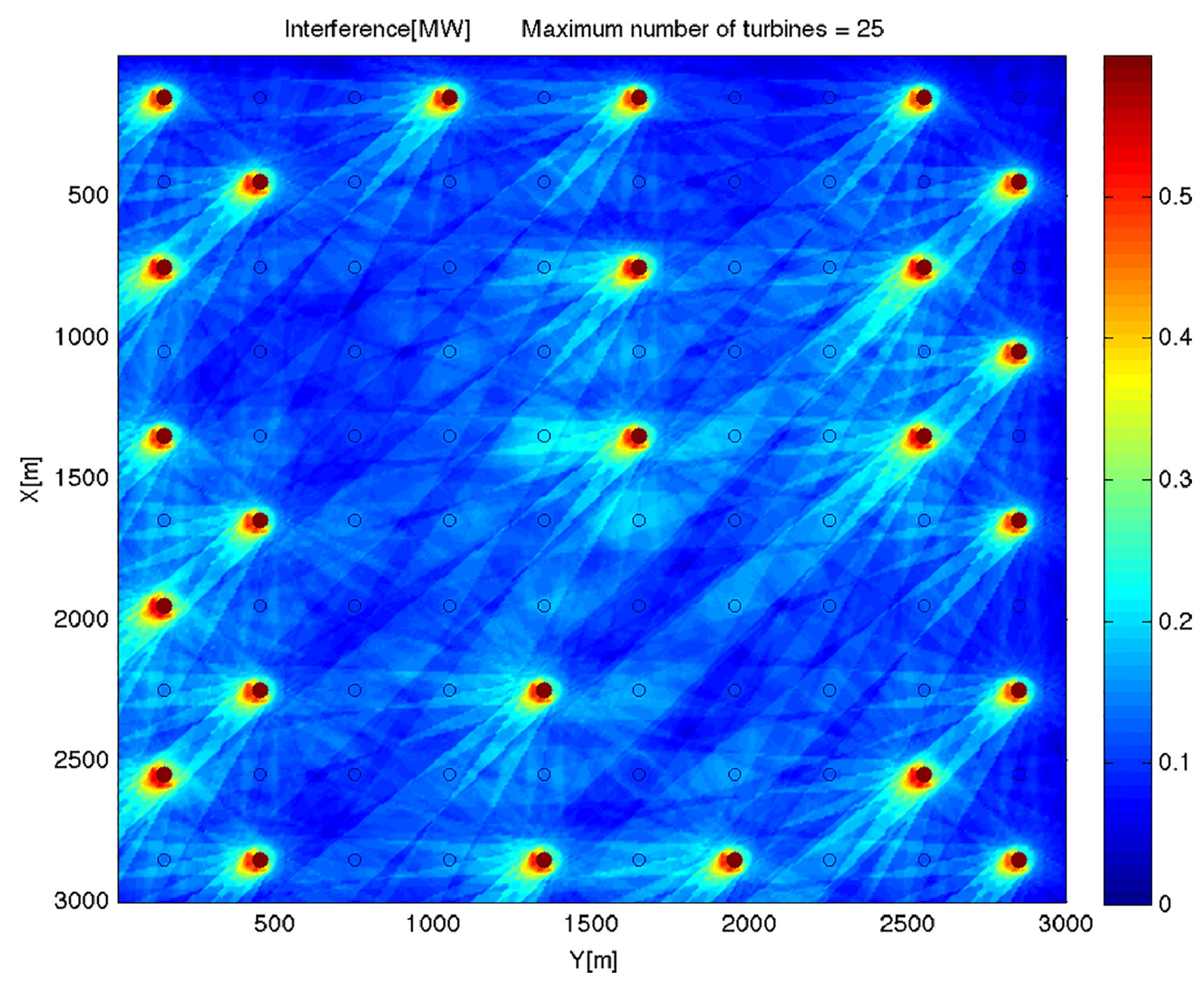
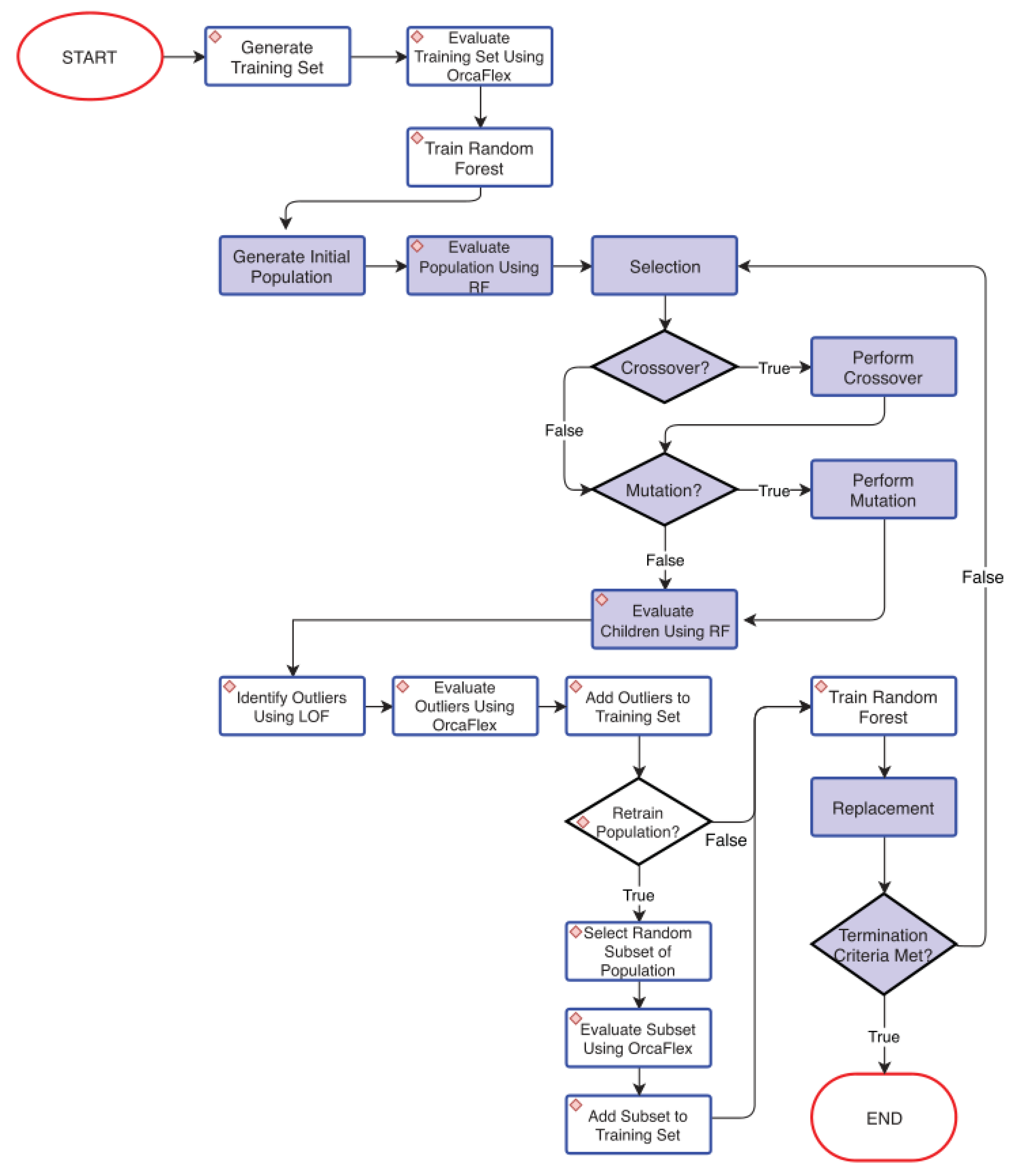
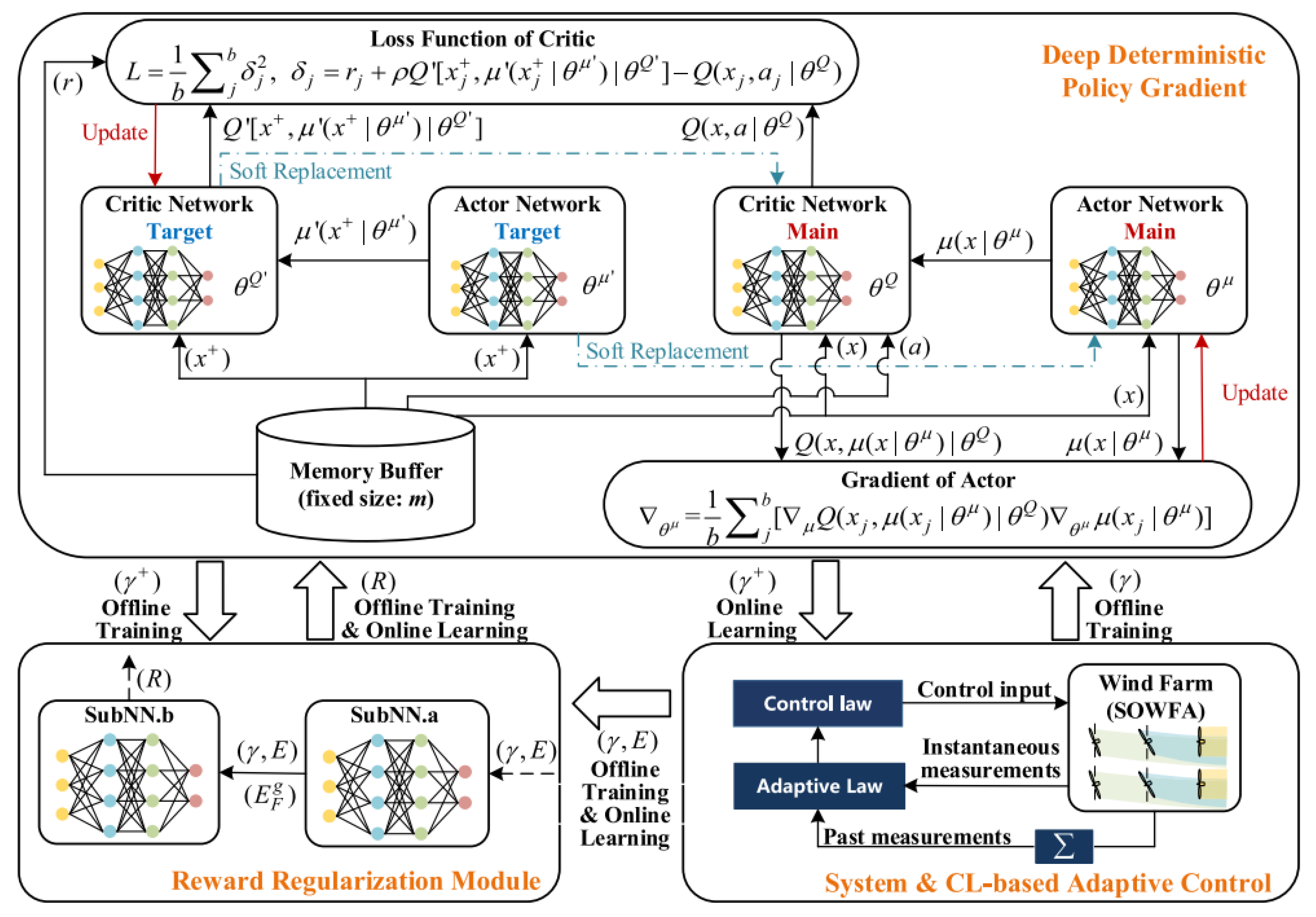
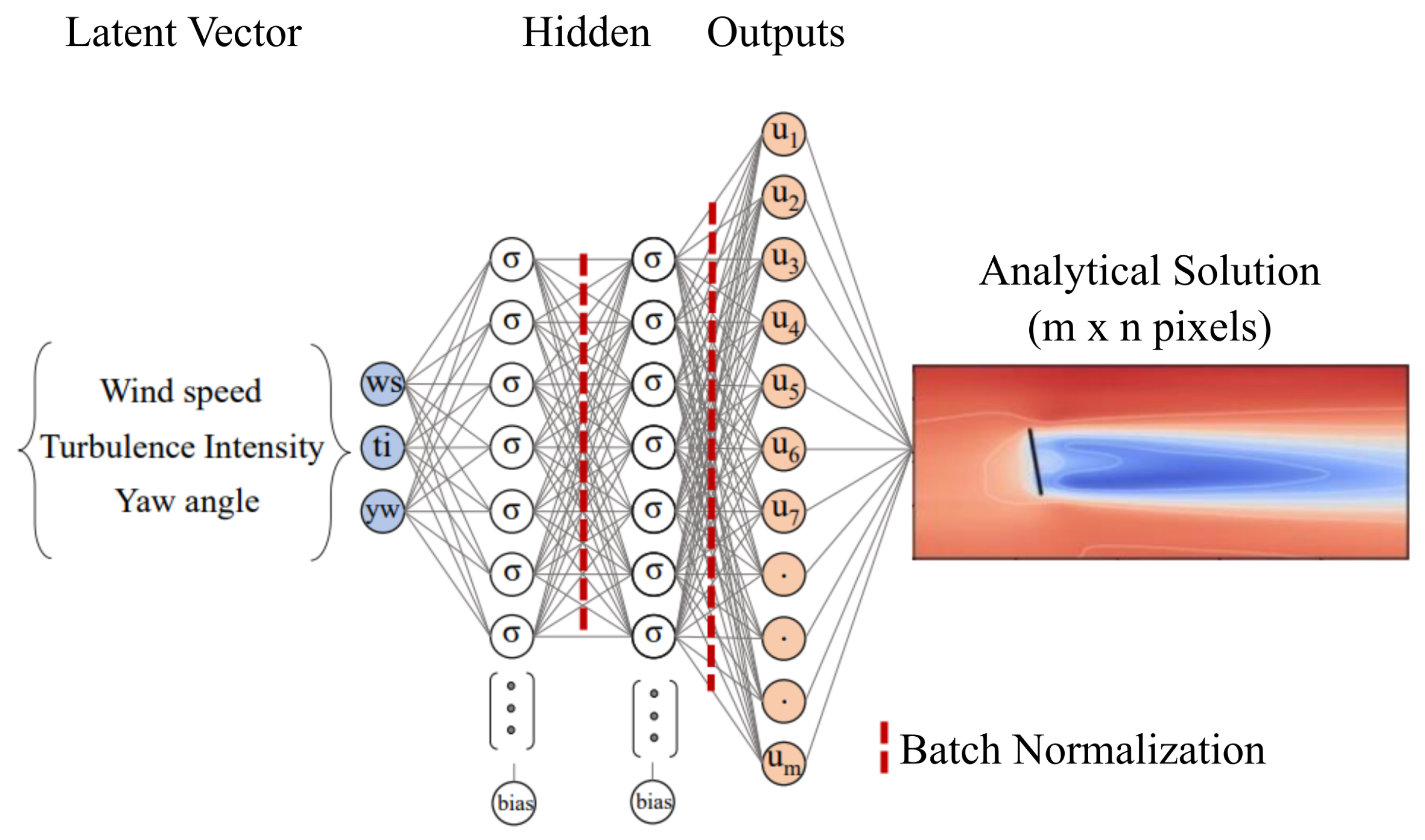
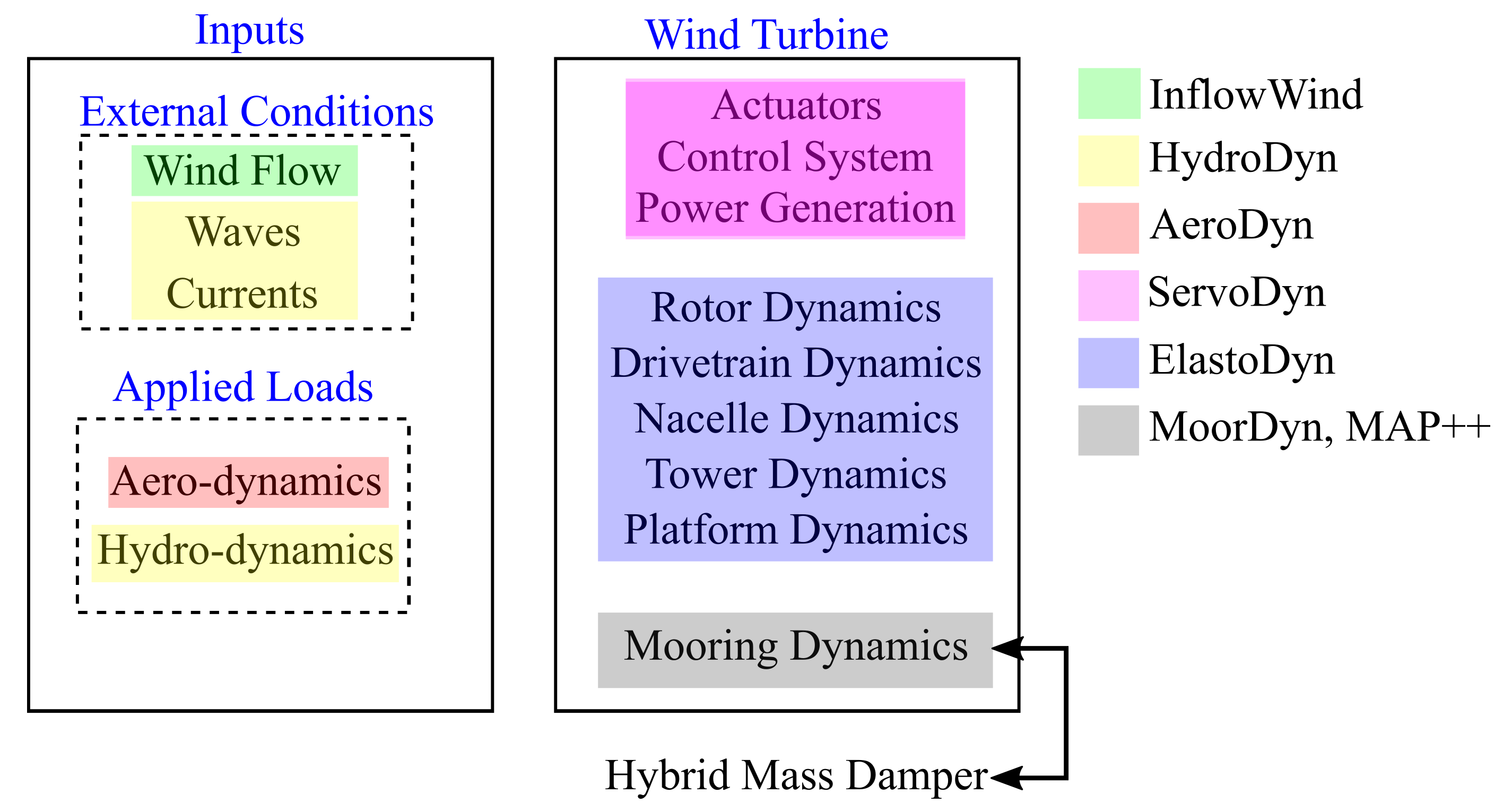
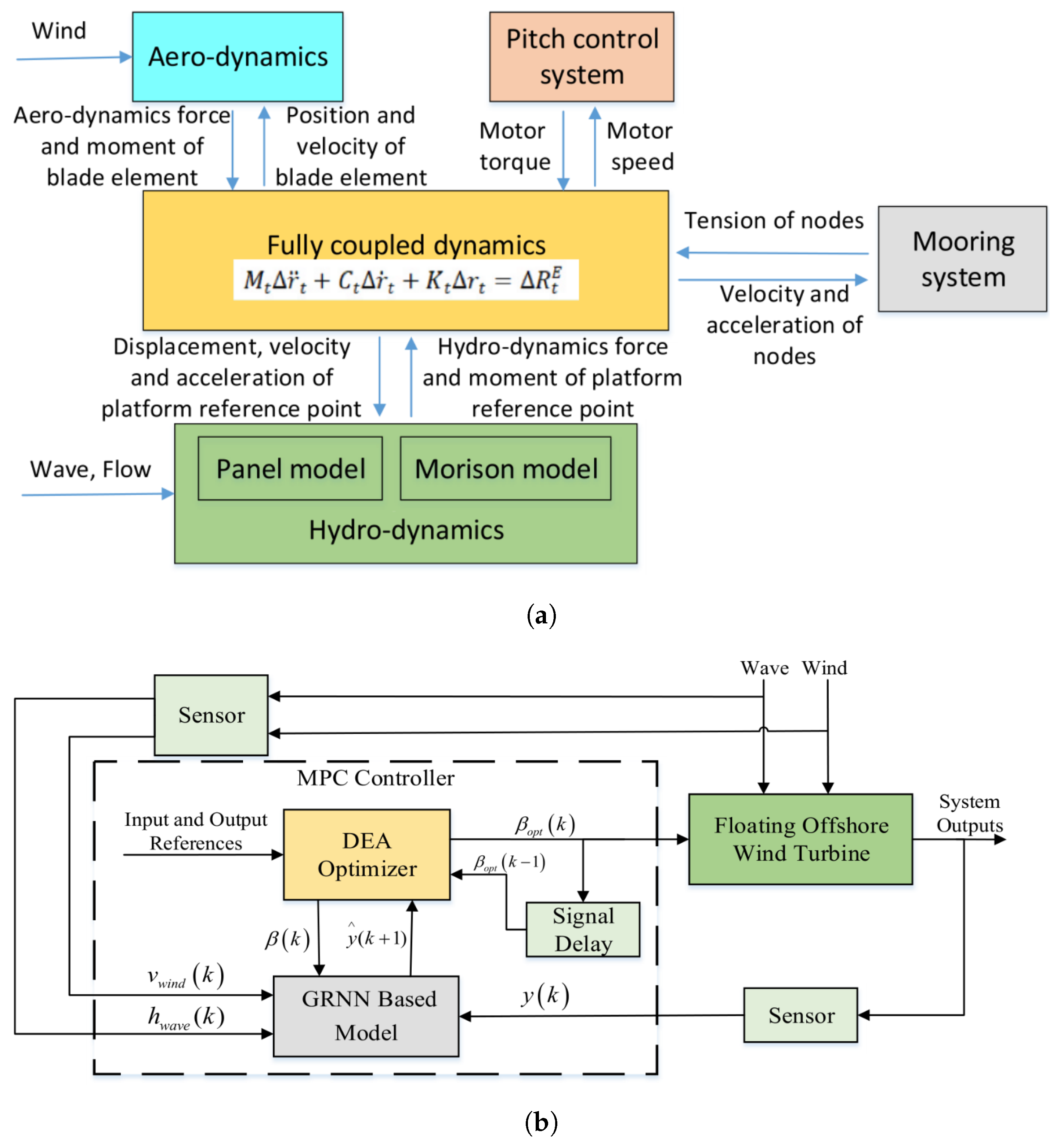
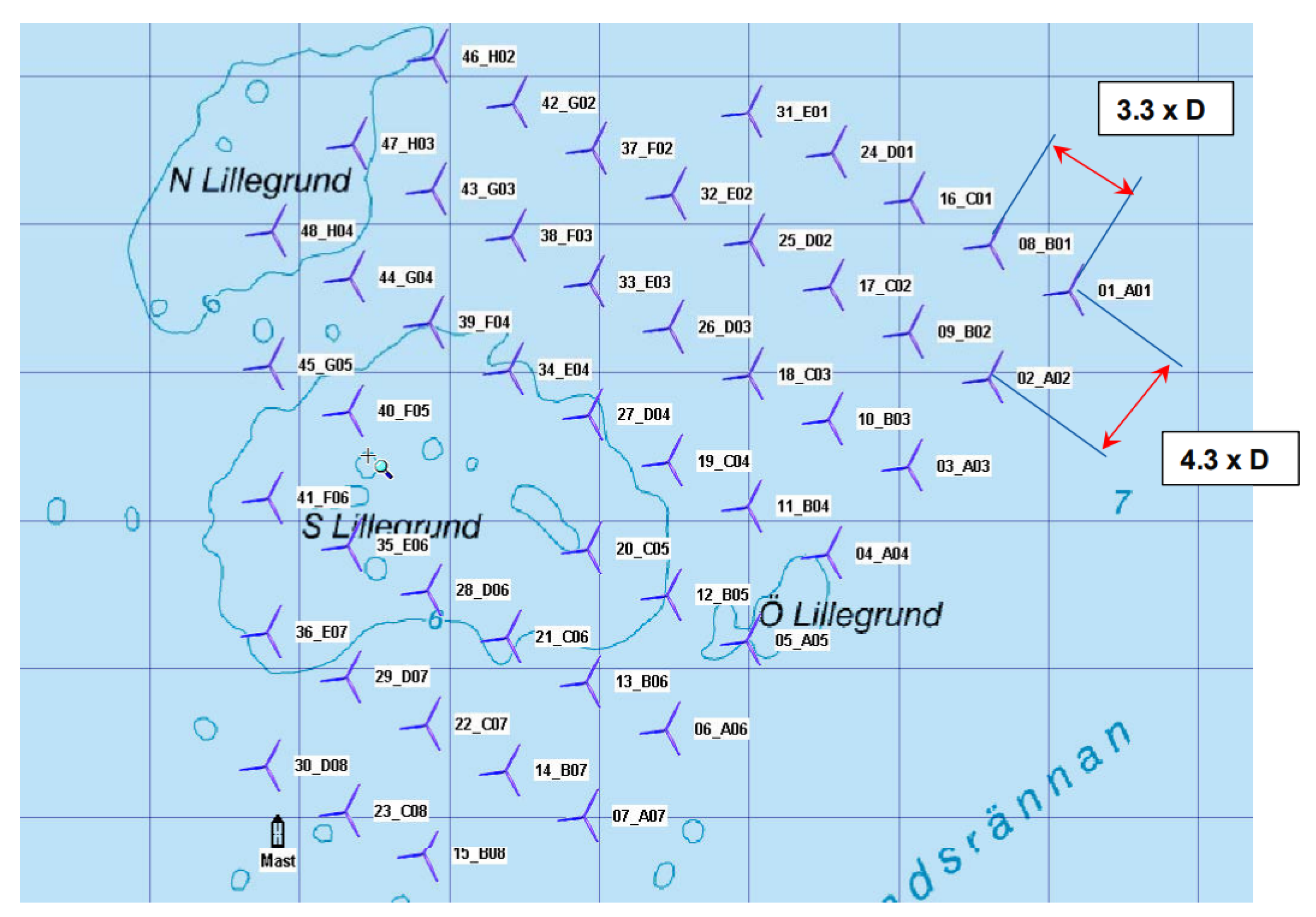
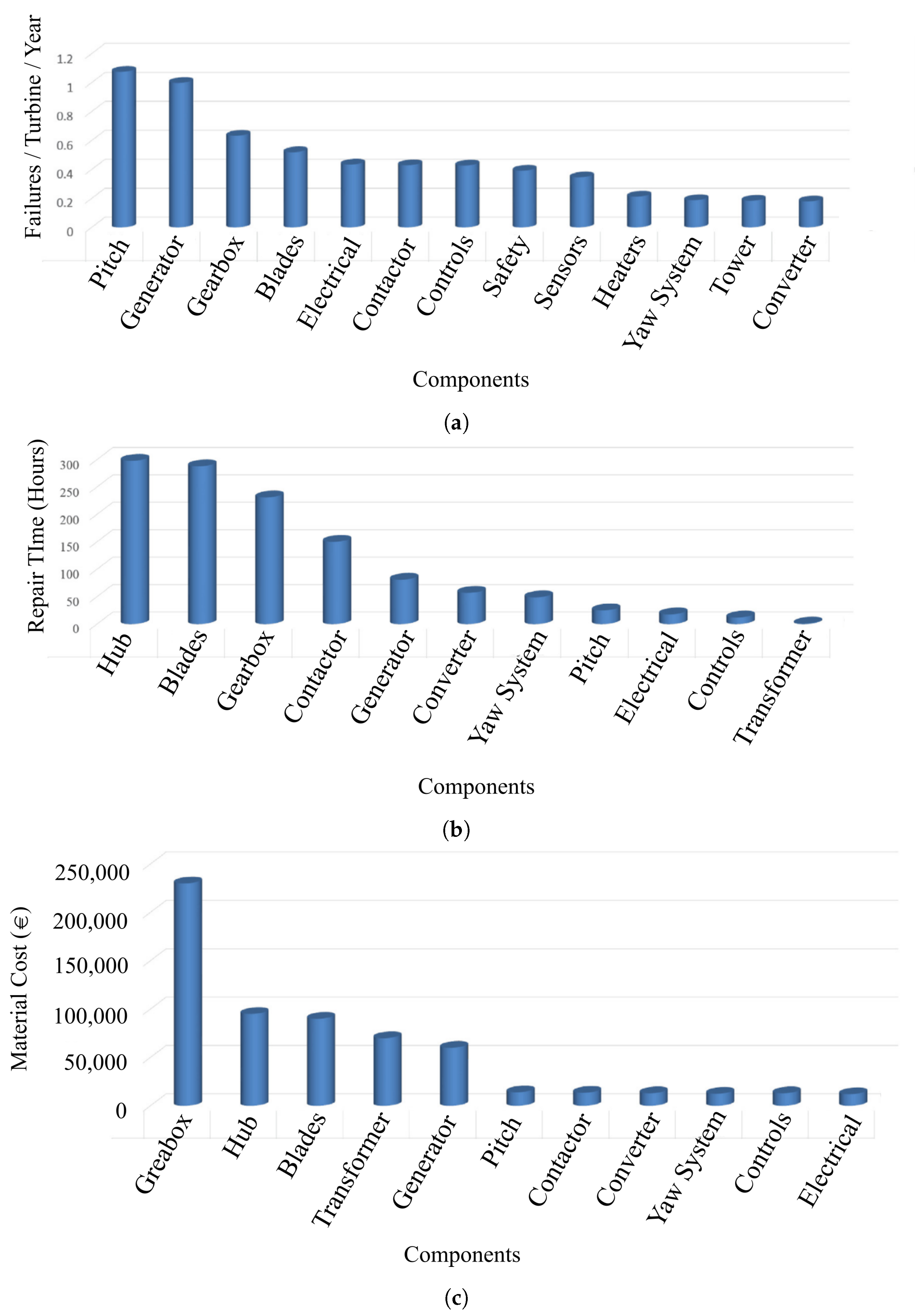
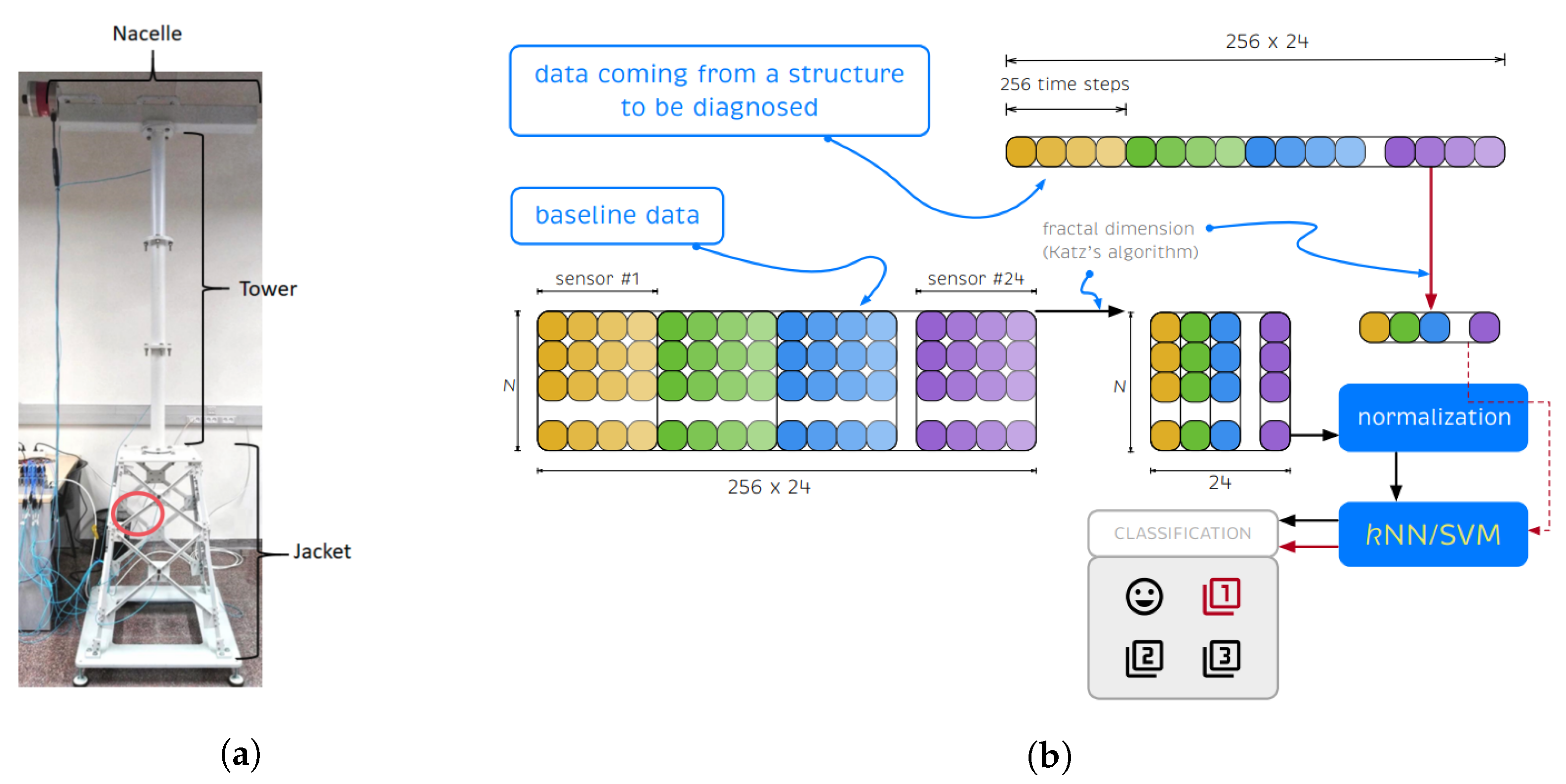

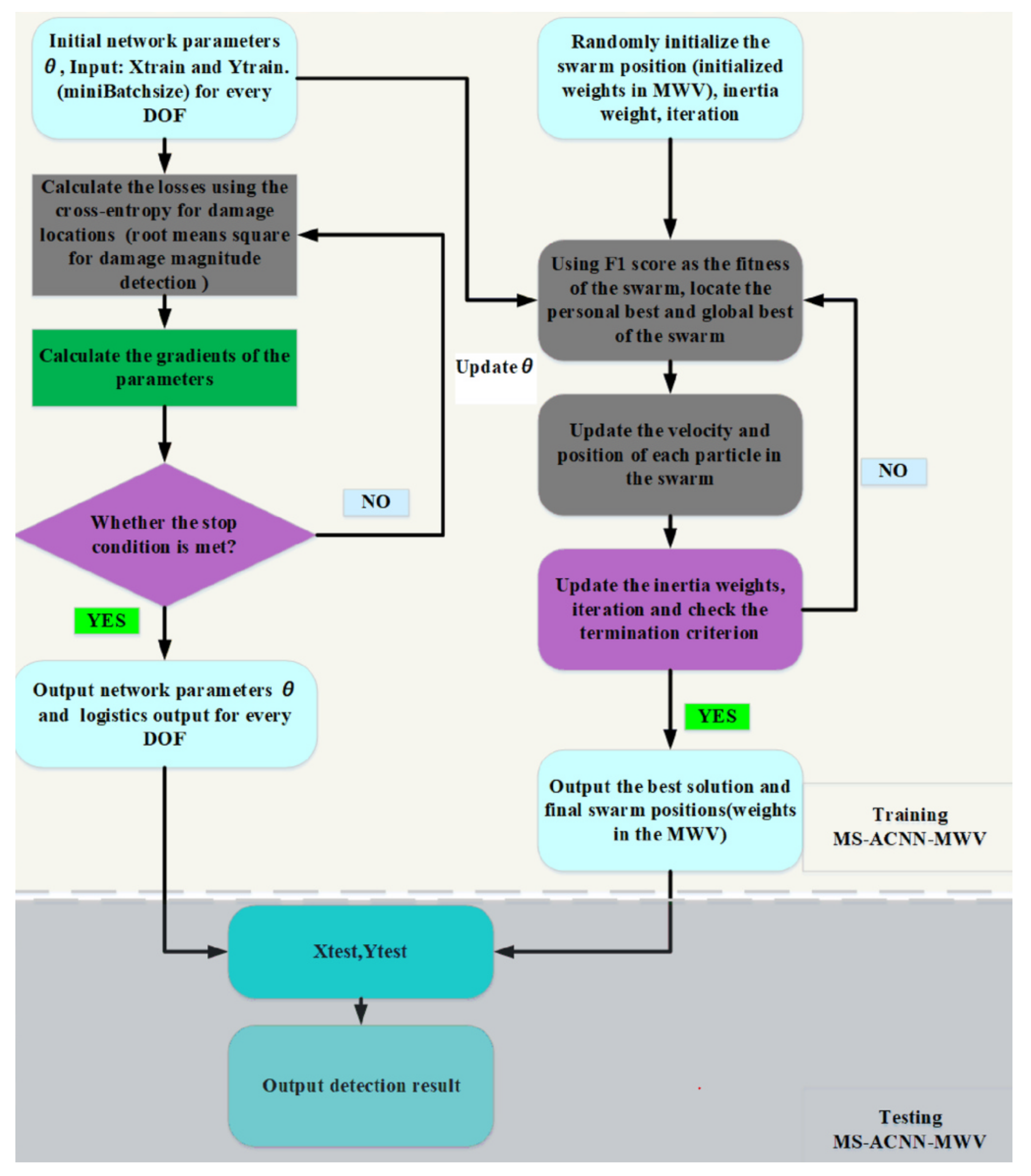
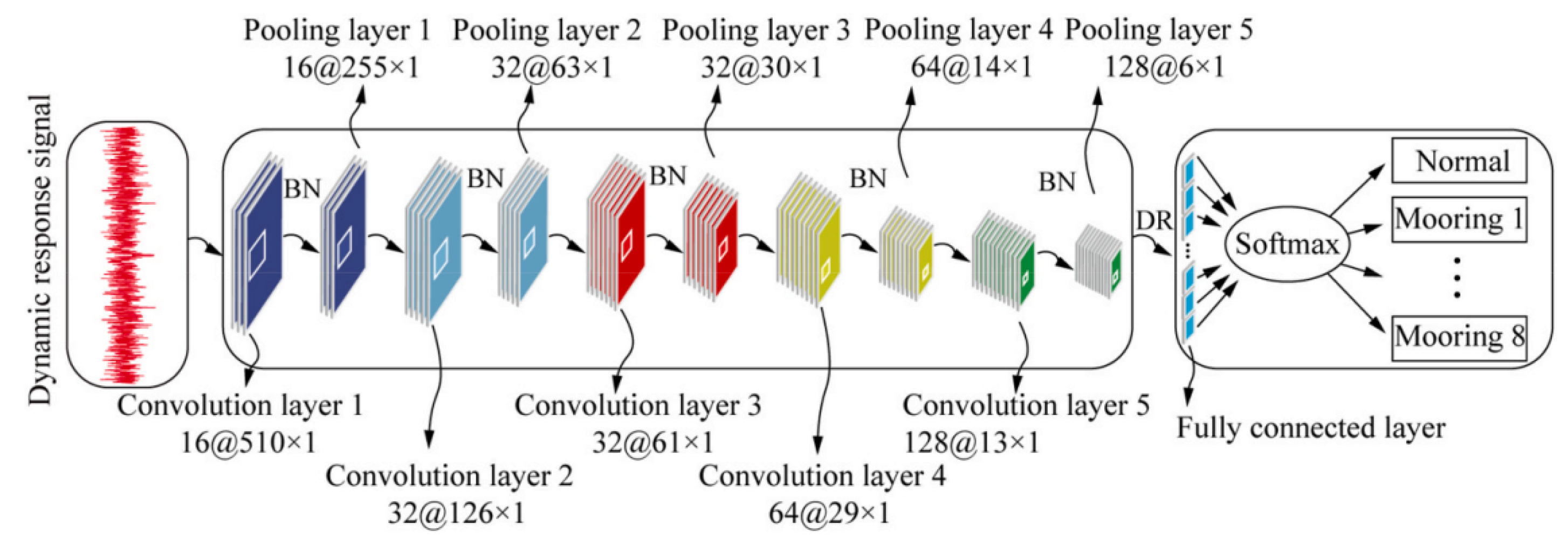
| Auth. and Cit. | ML Technique | Summary |
|---|---|---|
| Flores et al. [3] | MLP | Neural networks used to predict wind speed values in one-hour intervals. |
| Dankert and Horstmann [4] | MLP | Models were used to retrieve wind speed and wind direction from radar–image sequences. |
| Ma et al. [5] | Prony and SVR | Algorithms developed to forecast wave elevation and exciting force. |
| Niemi and Tanttu [7,8] | CNN, SVM | Bird identification system designed for offshore wind turbines. |
| Kulkarni and Ghosh [6] | MLP-based Framework | Special framework proposed to assess the impact of climate change on offshore wind potentials. |
| Yan et al. [9] | MLP | Windfarm power prediction using wind speed and direction. |
| Keivanpour et al. [10] | K-means Clustering | K-means clustering used to assess offshore wind energy potential worldwide. |
| Zha et al. [11] | Reinforcement Learning | Hybrid path-planning method combining A* and reinforcement learning for ship navigation in wind farm areas. |
| Lin et al. [12] | Unsupervised Learning | Unsupervised learning model used to discern various sound sources underwater. |
| Friedland et al. [13] | Random Forest | Random forest models employed to construct species distribution models for marine species. |
| Stelzenmüller et al. [14] | Random Forest | Random forest regression used to identify drivers of passive gear fisheries near offshore wind farms. |
| Van der Reijden [15] | Hierarchical Clustering | Utilized hierarchical clustering to identify distinct biological assemblages for demersal fish, epifauna, and endobenthos in the offshore Central and Southern North Sea. |
| Tapoglou et al. [16] | MLP | Used satellite images and the data from buoys to predict significant wave height and sea state in a wind farm. |
| Masoumi [17] | K-means Clustering | K-means clustering applied to group coastal regions based on wave height, wave period, and wind speed. |
| Hoeser et al. [18] | CNN | Deep learning-based object detection used to identify offshore wind energy infrastructure locations. |
| Hoeser et al. [19] | CNN | SyntEO methodology used to create deep learning-compatible datasets for Earth observation research, exemplified in the context of identifying offshore wind farms. |
| Nguyen et al. [20] | Decision Tree, Random Forest, Gradient-Boosting Regression Tree, and MLP | Models used to capture the complex relationship between wind conditions and wind farm power. |
| Mikami et al. [21] | Random Forest | Fine-scale spatial model using random forest to create a collision risk map for bird collisions with offshore wind turbines. |
| Xu et al. [22] | Global Random Forest | Global random forest model used to diminish noise and interference caused by ocean waves in synthetic aperture radar images. |
| Roy et al. [23] | Recurrent Neural Network | Four algorithms developed for identifying sea breeze and nocturnal low-level jet meteorological events. |
| Marin et al. [24] | MLP | MLP network used for wind speed prediction to optimize the siting of wind energy conversion systems. |
| Clare and Piggott [25] | Bayesian NN | Bayesian neural networks employed for predicting offshore wind resources with calibrated uncertainty predictions. |
| Yu et al. [26] | SVM | SVM optimized through the dragonfly algorithm used to enhance ultra-short-term offshore wind power prediction. |
| Auth. and Cit. | ML Technique | Summary |
|---|---|---|
| Lee et al. [28] | MLP | Development of optimization algorithms using neural networks for wind and bathymetric maps. |
| Pappala et al. [29] | MLP | Forecast wind characteristics as part of their optimization model for wind farm predictive control. |
| Japar et al. [30] | Linear Regression, Nonlinear Regression, MLP, SVR | Employed machine learning models to predict power output and estimate losses due to wake effects in large wind farms. |
| Antoniadou et al. [32] | MLP with Gaussian process | Used neural network Gaussian processes to construct reference power curves for wind turbines and predicting power output. |
| Rodrigues et al. [33] | Reinforcement Learning | Utilized reinforcement learning for online control of multi-terminal DC networks connecting offshore wind farms. |
| Ou et al. [34] | Recurrent Fuzzy Neural Network | Proposed an intelligent damping controller for offshore wind and wave power integration. |
| Fischetti and Fraccaro [35] | Linear Regression, MLP | Predicted the optimal production of offshore wind farms based on various factors. |
| Fischetti and Fraccaro [36] | Mixed Integer Linear Programming | Used machine learning to optimize wind farm layouts, including considering factors like wake effects. |
| Lu et al. [37,39] | Recurrent Fuzzy Neural Network, Recurrent Wavelet-based Elman Neural Network | Design of a damping controller for a Static Synchronous Compensator in an offshore wind farm as well as integration of wind and wave energy conversion systems using machine learning controllers for improved performance. |
| Noppe et al. [38] | MLP | Used a technique to reconstruct the thrust load history of a wind turbine using high-frequency SCADA data. |
| Häfele et al. [40] | MLP with Gaussian Process | Implemented Gaussian process regression for cost-effective optimization of offshore wind turbine jacket substructures. |
| Yin and Zhao [41] | General Regression Neural Network, Random Forest, SVM, Gradient-Boosting Regression, and Recurrent Neural Network | Created predictive models for offshore wind farms using various machine learning algorithms. |
| Pillai et al. [43] | Random Forest | Developed a multi-objective optimization for mooring systems of floating offshore wind turbines. |
| Li et al. [44] | MLP | Developed models for optimization of wind turbine systems, including mooring and blade pitch control. |
| Penner et al. [46] | MLP | Utilized models, including MLP and Frequency Domain Decomposition, for modeling and monitoring offshore structures. |
| Jonkman and Vijayakumar [47,48] | LSTM | Developed an advanced unsteady aerodynamics and dynamic stall model using an LSTM surrogate model for wind turbine load analysis codes. |
| Pandit and Kolios [50] | SVM | Proposed methods to quantify the uncertainty of an SVM-based power curve model using radial basis functions and confidence intervals. |
| Yu et al. [52] | Graph Neural Network | Utilized graph neural networks to connect wind turbines within a wind farm based on geographical locations, improving prediction accuracy. |
| Dong et al. [53] | Reinforcement Learning | Developed a deep reinforcement learning-based wind farm control scheme to optimize power generation under various wind conditions. |
| Lian et al. [56] | MLP | Developed an MLP-based regression model to relate loading conditions to the long-term performance of a foundation model for offshore wind turbines. |
| Chen et al. [57] | Reinforcement Learning | Proposed a simulation annealing diagnosis algorithm to optimize dynamic response prediction of floating offshore wind turbines using reinforcement learning. |
| Miao et al. [58] | MLP, Multiple Linear Regression | Used MLP network and multiple linear regression to evaluate the reliability of offshore wind farms considering climatic factors. |
| Mattsson et al. [59] | Gradient-Boosting Regression Model | Used gradient-boosting regression to generate synthetic hourly electricity demand series for large-scale energy system models worldwide. |
| Kheirabadi and Nagamune [61,62] | MLP | Used MLP networks in Distributed Economic Model Predictive Control to optimize power generation in floating offshore wind farms. |
| Yin and Zhao [63] | CNN-LSTM | Proposed a hybrid CNN-LSTM model for forecasting the outputs of offshore wind farms, achieving high prediction accuracy. |
| Anagnostopoulos and Piggott [64] | MLP | Developed an MLP-based model for wind farm flow field modeling using FLORIS wake fields. |
| Jothinathan et al. [66] | MLP | Used MLP-based controllers to handle the nonlinear dynamics of offshore wind turbine jacket structures. |
| Keighobadi et al. [67] | MLP with Radial Basis Functions | Designed an adaptive controller for floating offshore wind turbines using a radial basis functional MLP controller. |
| Kayedpour et al. [68] | MLP | Used MLP networks in Model Predictive Control to enhance the operational effectiveness of wind turbine control systems. |
| Zhang et al. [69] | Reinforcement Learning | Developed a reinforcement learning-based strategy for structural control of floating wind turbines. |
| Dehghan Manshadi et al. [70] | Recurrent Neural Network, LSTM, Random Forest, SVM | Developed models to predict power generation in a hybrid energy system combining vortex bladeless wind turbines and wave energy converters. |
| Velino et al. [72] | Machine Learning Control | Introduced a machine learning-based control approach using genetic programming for floating offshore wind turbines. |
| Yonggao and Yi [73] | MLP | Used MLP networks to predict capacities for onshore and offshore systems for reactive power compensation. |
| Meng et al. [74] | CNN, Bidirectional Gated Recurrent Unit | Developed models for ultra-short-term wind farm power prediction using real-time meteorological data. |
| Zhang et al. [75] | Gated Recurrent Neural Network | Proposed a multi-objective predictive control strategy for floating offshore wind turbines using gated recurrent neural networks. |
| Pham and Li [77] | MLP | Developed an MLP model for power flow predictions in offshore wind farms. |
| Chen and Hu [78] | Reinforcement Learning | Used reinforcement learning to predict the dynamics of floating offshore wind turbines and optimize key parameters. |
| Yang and Deng [79] | MLP | Employed an ML wake model to optimize wind farm layout while retaining existing turbines. |
| Ahmad et al. [80,81] | MLP | Developed an MLP-based model for a hybrid floating wave energy-wind turbine platform and introduced a fuzzy logic control system. |
| Auth. and Cit. | ML Technique | Summary |
|---|---|---|
| Hameed et al. [86] | Self-Organizing Maps, MLP | Used self-organizing maps and MLP networks to efficiently plan and execute maintenance and repair tasks. |
| Wang and Infield [87] | Nonlinear State Estimation, MLP | The models used for gearbox failure detection in wind turbines using historical data. |
| Dervilis et al. [88] | MLP | Prediction of blade-loading response based on power output data. |
| Pattison et al. [91] | Random Forest | Modular maintenance architecture for offshore wind farms. |
| Helsen et al. [92] | - | Component failure prediction in wind turbines using a big-data approach. Did not integrate actual ML techniques. |
| Li and Choung [93] | MLP | Fatigue damage prediction in mooring lines of floating offshore wind turbines. |
| Kandukuri et al. [96] | SVM | Bearing fault diagnosis in three-phase induction motors for offshore wind farms using SVM. |
| Muller et al. [99] | MLP | Fatigue analysis of floating wind turbines using MLP networks. |
| Li et al. [100] | MLP | Established a mapping between the environmental conditions of catenary mooring lines of offshore wind turbines and fatigue damages. |
| Lu et al. [101] | MLP | Prediction of wind turbine life percentage using condition monitoring information. |
| Papatzimos et al. [102,103] | SVM, Decision Tree, KNN, Logistic Regression, Bagging Ensemble | Integration of supervised and unsupervised learning for gearbox failure prediction. |
| Ziegler et al. [104] | Linear Regression, Nonlinear KNN | Load monitoring concept for wind turbines using strain gauges and regression algorithms. |
| Cavazzini et al. [105] | MLP | Prediction of power curve of turbines with damaged blade surfaces using MLP and CFD models. |
| Qiu et al. [106] | MLP | Prediction of damage in wind turbine towers using MLP with genetic algorithm. |
| Langenkamper et al. [107] | Mask R-CNN | Visual inspection of wind turbines using deep learning computer vision algorithms. |
| Wang et al. [109] | Decision Tree | Detection of faults in deep-sea transmission lines of offshore wind farms using wavelet noise reduction and decision trees. |
| Hoxha et al. [110] | KNN, SVM | Vibration-based monitoring for offshore wind turbine foundation damage detection. |
| Li and Zhang [111] | MLP | Probabilistic fatigue damage assessment in floating wind turbines using MLP-based approach. |
| Schröder et al. [112] | MLP | Correlation of loads with turbine reliability using physical modeling and MLP network. |
| Baboli et al. [113] | MLP | Condition monitoring and anomaly detection in wind turbine components using temperature sensors and MLP network. |
| Cho et al. [114] | MLP | Fault detection and diagnosis in hydraulic blade pitch system using a hybrid framework with Kalman filter and artificial neural network. |
| Pandit et al. [115] | MLP with Gaussian Process | Improved fault detection in wind turbines incorporating rotor speed and blade pitch angle. |
| Trizoglou et al. [116] | XGBoost Ensemble, LSTM | Fault detection in wind turbine generator subsystems using SCADA data and ML models. |
| Feijóo et al. [117] | Autoencoders | Damage classification in wind turbine structures using autoencoders. |
| Roelofs et al. [118] | Autoencoders | Interpretable method for anomaly detection using autoencoders. |
| Tang et al. [120,121] | SVM | Classification of internal transient overvoltages using mathematical morphology features and SVM. |
| Yeter et al. [122] | K-means Clustering | Life assessment and risk management for wind turbines. |
| Santos et al. [123] | MLP | Cost-effective sensor setups selection for accurate fatigue damage prediction. |
| Xu et al. [124] | CNN, Majority Weighted Voting | Diagnosing complex tendon damages in multibody floating wind turbines using deep CNNs and Majority Weighted Voting. |
| Eze et al. [125] | Extreme Gradient-Boosting Ensemble, Gaussian Naive Bayes, Decision Tree | Fault detection in subsea cables with ensemble learning. |
| Encalada-Davila et al. [128] | Gated Recurrent Unit | Detection of main bearing faults in wind turbines using a semi-supervised model. |
| Attallah et al. [129] | CNN, Linear Discriminate Analysis, SVM, KNN, Random Forest, Naïve Bayes, Decision Tree | Detection of interturn short-circuit faults in rotating machines. |
| Saleh et al. [132] | Reinforcement Learning | Combining Petri net modeling with reinforcement learning for wind turbine operation and maintenance optimization. |
| Sun et al. [133] | CNN | Detection of creep and mooring damage in floating wind turbines using CNNs. |
Disclaimer/Publisher’s Note: The statements, opinions and data contained in all publications are solely those of the individual author(s) and contributor(s) and not of MDPI and/or the editor(s). MDPI and/or the editor(s) disclaim responsibility for any injury to people or property resulting from any ideas, methods, instructions or products referred to in the content. |
© 2023 by the author. Licensee MDPI, Basel, Switzerland. This article is an open access article distributed under the terms and conditions of the Creative Commons Attribution (CC BY) license (https://creativecommons.org/licenses/by/4.0/).
Share and Cite
Masoumi, M. Machine Learning Solutions for Offshore Wind Farms: A Review of Applications and Impacts. J. Mar. Sci. Eng. 2023, 11, 1855. https://doi.org/10.3390/jmse11101855
Masoumi M. Machine Learning Solutions for Offshore Wind Farms: A Review of Applications and Impacts. Journal of Marine Science and Engineering. 2023; 11(10):1855. https://doi.org/10.3390/jmse11101855
Chicago/Turabian StyleMasoumi, Masoud. 2023. "Machine Learning Solutions for Offshore Wind Farms: A Review of Applications and Impacts" Journal of Marine Science and Engineering 11, no. 10: 1855. https://doi.org/10.3390/jmse11101855
APA StyleMasoumi, M. (2023). Machine Learning Solutions for Offshore Wind Farms: A Review of Applications and Impacts. Journal of Marine Science and Engineering, 11(10), 1855. https://doi.org/10.3390/jmse11101855





